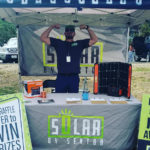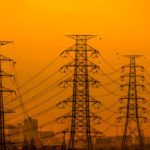Solar technology has progressed and been embraced by more than 2 million houses throughout the country since 1954, when scientists at Bell Telephone discovered that silicon-an element found in sand-created an electric charge when exposed to sunshine. Solar panel systems are becoming a very appealing option for households and businesses as a clean, economical energy source.
Solar panel systems: the basics
We can now harness the energy of an infinite source of power–the sun–thanks to the creation of solar panels. Solar panel systems operate in the following manner:
- Solar cells in your solar panels absorb sunlight energy during the day.
- Cellular circuits capture this energy and convert it to direct current (DC) energy.
- The direct current (DC) electricity is converted to the usable alternating current (AC) electricity that comes out of your wall sockets by passing it through an inverter.
- All of this implies that you can utilize the electricity in your home, store it in a solar battery, or transmit it back to the grid.
We’ll go over solar panel systems and the equipment you’ll need to generate power from the sun in the sections below. Already know how solar equipment works? Great! Check out the following articles in our Solar 101 department, or go to the next section to learn about the advantages of solar.
What are the components of a solar panel system??
Solar panel installations are extremely simple technologies. Any solar panel system has only four major components and no moving parts, making it incredibly easy to install and maintain. A solar panel system is made up of four parts:
- Solar photovoltaic panels–to convert solar energy into electricity
- Inverters–to convert DC electricity into AC electricity
- Racking and mounting systems–to affix your solar panels to your roof (or to the ground, depending upon your installation type)
- Performance monitoring systems–to track and monitor the output and health of your solar panels and inverters
Solar panels
What is a solar panel?
A solar panel is a device that absorbs and converts sunlight into useful electricity. Solar panels are typically composed of silicon-based solar cells, wiring, a metal frame, and a glass cover. A standard solar panel is four feet broad and six feet tall
Solar Panels consist of a series of silicon solar cells covered by a sheet of glass and held together by a metal frame, with wiring and circuitry in and behind the cells to collect the flow of electrical current out of the solar cells. Each solar panel, also referred to as a solar module, is typically about 4 feet by 6 feet in size, and weighs approximately 30 pounds.
Despite having no moving parts, the “active” component of a solar panel is in the silicon cells themselves: when sunlight hits the silicon solar cells, it activates electrons, which begin to flow through the cell. Wires in the cells capture this flow of electrons, which is then combined with the output of other cells in a solar panel.
Typically, solar cells come in either 60 or 72 cell formats. However, many companies are experimenting with new ways to increase the efficiency of the solar cells at converting sunlight into electricity current, so now you’ll see many “half-cut” solar panels, where each cell is cut in half so you have double the number of cells on the solar module (i.e., 120 or 144).
Not all panels are created equal
To find the right solar panels for your home and your wallet, there are a variety of criteria to keep in mind, including product quality, durability, and long-term performance.
Inverters
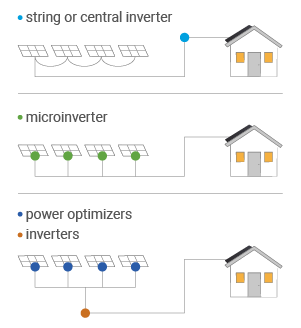
The cells in your solar panels collect the sun’s energy and turn it into direct current (DC) electricity. Most homes and businesses, however, use alternating current (AC). Inverters change the DC electricity from your panels into usable AC electricity. There are two basic types of solar inverters: string (or centralized) inverters and microinverters. String inverters can also add power optimizers to function similarly to a microinverter system.
String (or centralized) inverter: A single inverter connects your entire array of solar panels to your electrical panel. String inverters are frequently the least expensive inverter option, and are a very durable technology that have historically been the most commonly installed inverter type. Multiple strings of panels can be connected to each inverter; however, if the electricity production from one of the panels in a string drops (as may happen due to shading), it can temporarily reduce the performance of that whole string.
Microinverters: If you choose microinverters, one is (usually) installed at each solar panel, which allows each panel to maximize production. If some of your panels are shaded at different times of day or if they aren’t all installed facing the same direction, microinverters will minimize performance issues. The cost of microinverters tends to be higher than the cost of string inverters.
Power optimizers: Systems that use power optimizers are a hybrid of micro-inverter and string inverter systems. Like microinverters, power optimizers are installed at each panel. However, instead of converting the DC electricity from the solar panels into AC electricity, the optimizers “condition” the DC electricity before sending it to a centralized inverter. Like microinverters, they perform well when one or more panels are shaded or if panels are installed facing different directions. Power optimizer systems tend to cost more than string inverter systems, but less than microinverter systems.
Racking and mounting systems
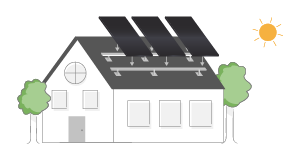
Solar racking and mounting systems are the pieces of hardware that affix your solar panels to your roof or to the ground.
To perform at their best, solar panels should face south and be installed at an angle between 30 and 45 degrees (depending on how far you are from the equator). Panels facing east or west and at a pitch angle of five degrees or more will still work well, but will produce 10 to 20 percent less electricity than those installed under ideal conditions. For residential solar, most roof-mounted systems are “lie-flat” systems, which means the pitch of your solar panels parallels the pitch of your roof. In some cases, though, you can use racking to tilt or position your panels at an angle that is best for capturing the sun’s rays.
There are two types of mounts: fixed mounts, in which the panels remain stationary, and tracking mounts, which allow panels to “follow” the sun as it moves across the sky during the day (single-axis track mounts) and during the changing seasons (dual-axis track mounts). Tracker mounts are only suitable for ground mounted solar.
Performance monitoring systems
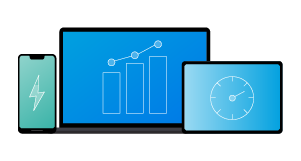
Performance monitoring systems provide you with detailed information about the performance of your solar panel system. With a monitoring system, you can measure and track the amount of electricity your system produces on an hourly basis.
The most frequently used inverters in the residential market all come with production monitoring apps so that you can track the output of your panels. In some cases, the app will also provide consumption monitoring to help you track the overall savings from your solar panel system. Note: this additional consumption monitoring may come at an extra cost.
Monitoring your solar panel system can help you to identify any performance issues to help ensure that you maximize the electricity production–and financial returns!–of your solar panel system.
There are two primary types of monitoring systems:
- On-site monitoring: The monitoring device is physically located on your property and records the amount of electricity produced.
- Remote monitoring: Your solar PV system transmits its performance data to a monitoring service that you can access online or with a mobile device.
Start your solar journey today with Energy
